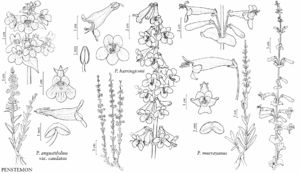Penstemon murrayanus
Bot. Mag. 63: plate 3472. 1836. (as Pentstemon)
Stems ascending to erect, 50–100(–150) cm, glabrous. Leaves basal and cauline, glabrous; basal and proximal cauline 40–100 × (8–)14–30 mm, blade spatulate to ovate, base tapered, apex rounded to obtuse, rarely retuse; cauline 5–9 pairs, sessile, 12–110 × 16–70 mm, blade oblong to ovate, base clasping to connate-perfoliate, apex obtuse to acute. Thyrses interrupted, cylindric, 15–50 cm, axis glabrous, verticillasters 6–10(–16), cymes 1–5-flowered; proximal bracts ovate, 9–45 × 14–40 mm; peduncles and pedicels glabrous. Flowers: calyx lobes lanceolate, 4.5–7 × 1.8–2.9 mm, margins entire, narrowly scarious, glabrous; corolla red, without nectar guides, tubular-funnelform, 32–36 mm, glabrous externally, glabrous internally, tube 8–11 mm, throat abruptly inflated, 9–12 mm diam., rounded abaxially; stamens exserted, pollen sacs opposite, explanate, 1.3–1.7 mm, sutures smooth; staminode 18–20 mm, exserted, 0.2–0.3 mm diam., tip straight to recurved, glabrous; style 24–31 mm. Capsules 9–13 × 6–10 mm.
Phenology: Flowering Mar–Jun.
Habitat: Sandy soils, deciduous and pine woodlands, sandhill prairies.
Elevation: 10–200 m.
Distribution
Ark., La., Okla., Tex.
Discussion
F. S. Crosswhite and C. D. Crosswhite (1981) hypothesized that Penstemon murrayanus was derived from P. grandiflorus, with which it shares many morphologic features. The two species have been crossed artificially, yielding hybrids that once were commercially popular (G. Viehmeyer 1958; R. Nold 1999). Molecular data support the sister relationship of P. murrayanus and P. grandiflorus (C. A. Wessinger et al. 2016).
Selected References
None.
